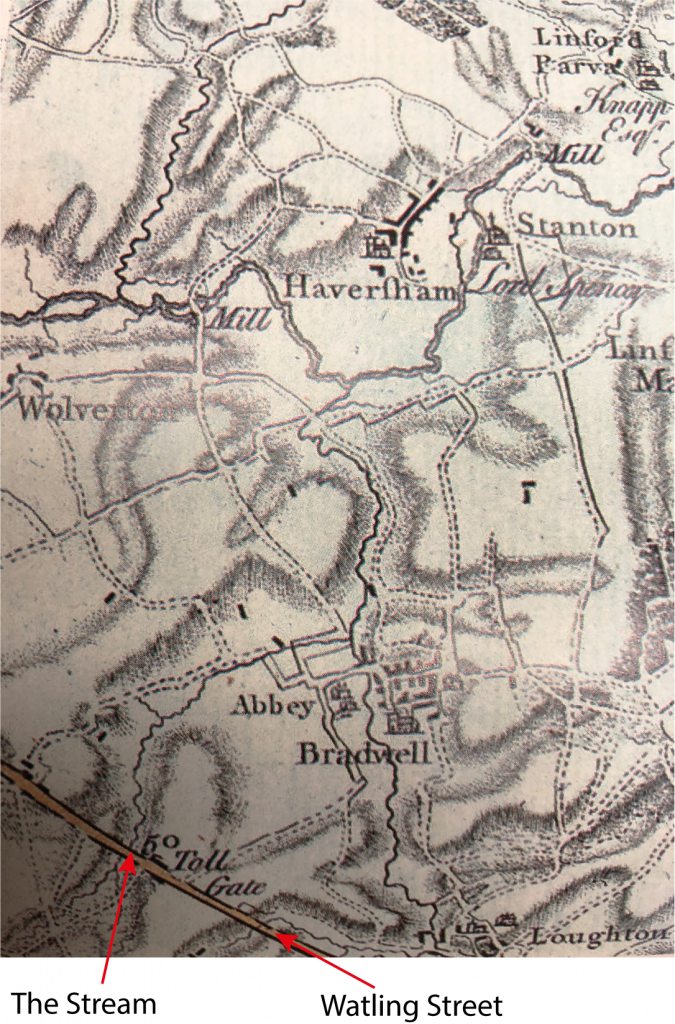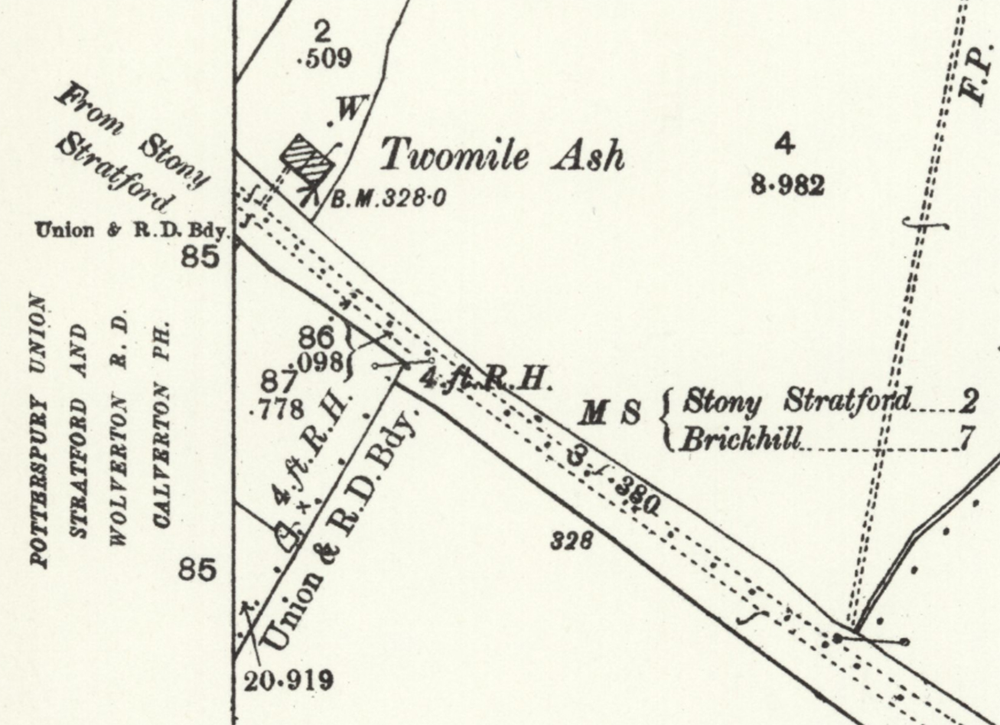The Bluebell Circuit and touching local history
As people walk the Bluebell Circuit and enjoy the natural environment, few will realise just how close to local history they have come. Below are several topics that will introduce you to the hidden history that is part of the Bluebell Circuit.
Take a rest from your walk, look around and imagine times past.
Watling Street – the road the Romans built and one of the most famous roads in the UK.
As you stand on the bridge, turn to face the V4 road or ‘Watling Street’. You will hear the noise of vehicles traveling back and forth, but if you can transport yourself almost two thousand years into the past the noise you would hear would be the Roman infantry marching north and south.
Although this route was present in Saxon times probably as no more than a grassy track, the Romans significantly improved key roads to aid communication and Watling Street was one of the most important Roman roads in Britannia, Roman governed Great Britain. It begins in Dover in Kent, passing through London and St Albans towards the northwest and Wroxeter. Stony Stratford was an important point to cross the flood plains of the River Ouse. ‘Straetford’ in Old English means a ford by which a Roman road crosses a river.

Close your eyes and imagine the legions of Roman soldiers marching towards the great battle with Boudica and the Iceni who had attacked Londinium (London) and Verulamium, (St Albans).
The small stream that the bridge crosses can be found on many maps going back hundreds of years and may well have been here when the Romans improved Watling Street.

Old maps of the area (like the one above), can be accessed at our wonderful library in Central Milton Keynes.
You can see how our modern construction engineers have made a concrete ‘tunnel’ to allow the water to pass under the V4. If you look carefully to the right of the tunnel you might make out a partially covered curved arch, part of a previous construction to let the water pass under the road. You might wonder how the Roman ‘engineers’ crossed this small stream with their amazing road-building techniques.
The Toll House once stood on the western edge of Two Mile Ash and was used to manage the tollgate on Watling Street at a time when you paid to use the road.

Stop at the point close to the Gate onto the Redway and you are now standing where the toll house once stood. Early maps show two buildings (homes) and a well at this point.
The road from Fornhill (Beds.) to Stony Stratford was the earliest turnpike road in England to be controlled by a body of trustees. The Fornhill to Stony Stratford Turnpike Trust was set up in 1706 and later extended SE to Hockliffe. In 1755 the trustees authorised their surveyor to ‘pick and gather stone in Bradwell fields for the repair and mending of the turnpike road’. In 1771 gravel was to be carried from private land, payment being made for any damage caused. Nevertheless, the road from Fenny Stratford to Stony Stratford was described as ‘miserable indeed’ by James William and Jacob Malcolm in 1794.
In the Bucks section of the road there were two toll gates. That at Fenny Stratford was by the 44th mile post, on the SW corner of the crossroads leading N to Walton and S to Great Brickhill. At Two Mile Ash a house by the 50th mile post which served as a toll house was ‘still’ being rented from Lord Salisbury in 1744 and 1755. Both gates were still in use and up for tender for a year in 1866. The trustees agreed to the erection of a weighing engine at Two Mile Ash in 1774, to be kept in repair at a cost of two guineas per annum. The gate keeper was to be given an additional payment for operating it. The engine was still in use in 1806. The turnpike to Stony Stratford was ended in 1867.

The OS 1841- 1952 extract above shows ‘Twomile Ash’ and the existence of two buildings side by side with a well. Once the Toll house, the two buildings were to become ‘cottages’ once again and served as accommodation for families working on farms close by.
Meet the neighbours
Before the development of our ‘modern’ estate, Two Mile Ash was part of the Bradwell Abbey Farm estate. The only homes amongst the fields were two small cottages close to Watling Street. If you stand close to the ‘gate’ then you might imagine these two small homes to so many families, with such a lot of local history.
The ‘Two Mile Ash Cottages’ were a pair of stone and tiled cottages built before 1750 and each containing three bedrooms, kitchen, scullery with water from a well. The buildings fronted onto Watling Street. During the late 1700’s and early 1800s they were used as a tollhouse for the Watling Street turnpike and a site for the weighing machine used to check the weight of carriages going through the tollgate.
So who were our neighbours from the past? Census information derived from Ancestry UK offers us some insights!
In 1841 Cottage 1 was occupied by The West family.
William West, a 62 year old agricultural labourer and Sarah West his 57 year old wife.
Together with James (aged 20), Anthony (aged 28), Esther (aged 23), Job (aged 3) and Sarah (aged 20).
Cottage 2 was home to Samuel Lovesy (agricultural labourer aged 72), Jane Hawkins (aged 27), Eliza Hawkins (aged 3 months) and John Hawkins (aged 2).
The Bradwell Abbey land was being farmed by William Bennet (aged 30) and one of his employees was James Hawkins (aged 30), who I suspect was Jane’s husband.
In 1851 the Bradwell Abbey is being farmed by Robert Adams (aged 40).
Cottage 1 is still occupied by William and Sarah West now into their late sixties.
Cottage 2 is home to John West (an agricultural labourer aged 39) and his wife Sophia (27).
Daughters Maryann (7) and Elizabeth (2) and a son Henry James (6 months).
By 1861 the land is being farmed by Robert Adams (junior – aged just 25)
In Cottage 1 William is now an 80 year old agricultural labourer and sadly has lost his wife Sarah. He shares the cottage with ‘boarders’; Joseph Carter (Agricultural labourer – 63), Catherine Carter(64) and James Whitehead (Agricultural labourer – 30)
Cottage 2 is occupied by James Groom (Agricultural labourer – 29) and his wife Elizabeth Groom (Straw Platter – 23), and daughter Mary (4)
and now it is 1871
The Bradwell Abbey Farm is back under the stewardship of Robert Adams (senior), now a widower and aged 60.
Cottage 1 appears to be unoccupied.
Cottage 2 is home to Thomas Adams (Farm labourer – 44) and his wife Ellen (34) and daughter Hannah (1).
In 1881 Bradwell Abbey Farm is managed by Samuel Punter (52).
Only one of the TMA cottages is occupied by quite a large family;
George Markes (Farm labourer – 37), his wife Jane (38), a daughter Caroline (a general servant – 18), a son Newman (labourer – 17), daughters – Harriet (10), Mary Ann (8) and Kate (4), plus two more sons – Arthur (6) and Frederick (1).
By 1891 Samuel Punter (62) is still looking after the Bradwell Abbey Farm.
The TMA cottages are now occupied by;
Cottage 1, Thomas Walduck (a Farm labourer – 42) and a widower.
His daughters Gertrude Mary (13 year old Housekeeper), Edith Emma (11) and Margaret Elizabeth (7). Also a boarder Edward William Ward a 26 year old railway worker.
Cottage 2 is home to Richard Plumb (Farm labourer – 53) and his wife Norton Dinah (57), together with their son George Plumb (Farm labourer – 20).
By 1901 Albert Punter (43) and his family manage the Bradwell Abbey Farm.
Cottage 1 is home to Arthur Illing (a widower, Milkman and labourer – 39)
Together with his sons; Barnett (17), Albert (16), George (13) – all farm labourers.
Daughters Kate (11), Rose (9) and Annie (5),
A son Lewis aged 2 and a baby son one month old. Suggests his wife lost her life very recently and perhaps after childbirth.
Ann Clarke (Housekeeper – 38).
Cottage 2 is occupied by Richard Plumb (Farm labourer – 63) and his wife Norton Dinah (67)
In 1911 Cottage 1 is home to John Smith (Waggoner – 34) and his wife Clara Jane (30),
daughters Alice Sarah Jane (7), Rose Hannah (4) and Winifred Clara (5 months)
and a son John Alfred (2).
Cottage 2 is occupied by Steven E Alderman (Farm labourer – 33) and his wife Ellen (19) together with a daughter Jane Ellen of 6 months age.
and finally…
In April of 1950 as the Bradwell Abbey estate is being sold, the two cottages are occupied by familes of the names; W.Savill and R.Toombs.
Lots more information can be found through the Buckinghamshire Archives.
Both cottages were occupied in the 1950s and perhaps into the sixties, but they were lost as MK ‘arrives’ and with that a lot of history. Perhaps you know what happened to them, please let us know if you have some local history to add!